|
|
|
|
| Krumovo (open store) Krumovo Air Base (24.VAB) Graf Ignatievo Bezmer |
| Military Photography in Bulgaria Bezmer Forward Operating Base Plovdiv - Krumovo Air Force Base Graf Ignatievo Air Force Base June 2009, April 2010 |
| Base visits can often be more about what or where you can’t photograph, rather than being given freedom to photograph what you like. All military bases have their sensitive areas with aircraft equipment which must not be photographed. My visits to three Bulgarski Voennovazdyshini Sili - BVVS (Bulgarian Air Force - BuAF) air bases, approved by Gen Simonov, Chief of the Air Force, were subject to a string of restrictions, each creating their own challenge. The ‘Cold War’ for Bulgaria ended some time ago, as has its membership of the Warsaw Pact. Bulgaria is now a member of NATO signing up in 2004, joining the European Union in 2007, Bulgaria is now a very different country. This is my personal account of how I got my photographs during my two week-long visits to a fascinating Bulgaria. |
 |
| The open storage area on Krumovo air base (24.VAB). |
| Bezmer
My first visit was to the Forward Operating Base of Bezmer. In Lt Col Dimitar Danev's office, Base Commander for Bezmer was very welcoming, offering me coffee once I was seated in his spacious office. Bezmer is the home of BuAF’s Sukhoi Su-25 Frogfoot ground attack aircraft and the former home of the Su-22. A fuel restriction, I was told, meant that there would be no flying at Bezmer for the foreseeable future. I knew that there were still a number of Su-22s stored on base with some withdrawn Su-25s amongst some Hardened Air Shelters (HAS) and were up for disposal. We discussed what I was hoping to achieve during my day on base. My request was to photograph both the Su-22s and Su-25s in the HAS area and following some snapped orders, a member of the General’s staff left the room. Returning some minutes later he was apparently the bearer of some bad news. I was told that in consultation with Bulgarian National Security I was not allowed to visit the HAS area. All was not lost however, any aircraft I wanted to photograph could be brought to me. I suggested a Su-22 a Su-25K single-seat and a Su-25UBK two-seat. The order was issued for these three types to be towed to an area of revetments adjacent to the control tower. I could position the jets exactly as I liked, combining the best angles with the sun with the most attractive backgrounds. Over the next couple of hours I photographed them from every angle, from steps and with the cockpit open and closed. I was able to shoot from the revetment and even from the roof of the control tower. Each aircraft got the attention it deserved, I had travelled virtually through the night to make this photo shoot and was going to make the most of it. The Su-22 (612) which had suffered from two years of being in open storage created its own problems for those in charge, it was suggested that I should not photograph it until it was cleaned. A surprisingly enthusiastic group of workers appeared from nowhere, with buckets and brooms and set to work on cleaning this large jet by hand. They were a little embarrassed as I snapped them while they worked. Later I could see what looked like a maintenance hangar and asked if I could take some pictures inside. While permission was sought for this, we went for lunch in the Officer’s mess. Here we had a bowl of refreshing 'tarator' which is cold cucumber and yoghurt soup, this was followed by chicken and cucumber. Yes the Bulgarian’s like their cucumber during the hot summers. Permission had now been granted to go to the maintenance hangar, but on arrival the man in charge said I could only photograph one of three Su-25s undergoing maintenance. I thanked him and worked my tripod around my chosen jet. I never did find out the reason why only one could be photographed. |
 |
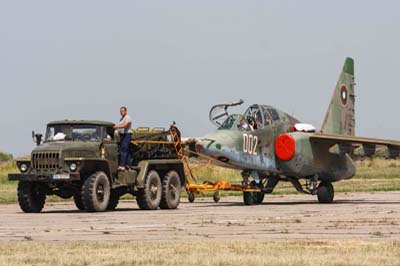 |
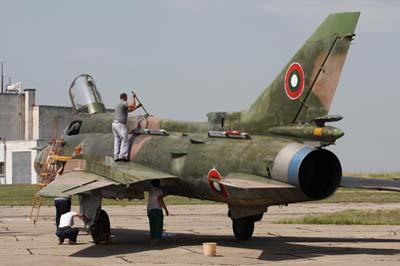 |
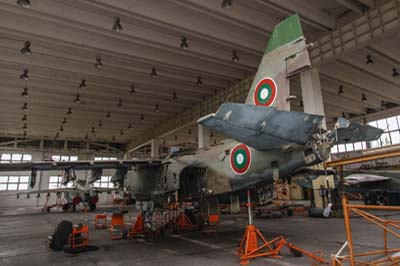 |
| Left to right: Area 1 HAS's and the withdrawn Su-25's with painted out serials outside. The wingspan is too wide for the shelters. The Su-25UBK 'Frogfoot' being towed into position. The Su-22M-4 'Fitter' being cleaned for my camera. The maintenance hangar with three Su-25's, I was only allowed to photograph Su-25K (230 in the background are Su-25K '254' and Su-25UBK '047'). |
| Graf Ignatievo Again in the Base Commander’s office, with General Ramen Radev I was told of the fuel restriction which was preventing base flying. Our short conversation was interrupted by the sound of a jet circling the air base. This was a MiG-21bis-SAU 'Fishbed' (427) which was performing a test flight and not subject apparently to any fuel restriction. Anxious to photograph any BuAF jet in flight I was told that I could be driven to the ramp immediately, sadly I was too late, it was already on the ground and being refuelled. Still this was some action that could be photographed. The base tour took in quite a few MiG-21’s, some obviously active (I had heard one of them) most in open store, with their serials and national markings painted out. These were apparently no longer in the charge of the BuAF but an outside agency and were awaiting disposal. I believe around ten BuAF MiG-21s are still active but on base personnel suggested that the figure was nearer four. Photography here seemed unrestricted, even around the MiG-29 maintenance hangars apart from the Quick Reaction Alert (QRA) ramp. Later I was told I could photograph a MiG-29 performing an engine vibration test at close hand. I was not expecting it to be so close, I could stand just a couple of meters away from the cable anchored MiG when it doing the engine check. Only one engine at a time could be put into afterburner (or reheat) as the cables might not hold it. Bizarrely I was told that I could not take photographs during this test for a reason that I will not elaborate, apart from saying that I complied completely and their unexplained secret is safe with me, whatever it was. The promised night-flying did not materialise, leaving me somewhat bemused as to whether it was actually cancelled or merely a rumour to raise my hopes. A year later I was on base again. Previously my request to photograph the two MiG-29s on QRA duty was denied by the base commander. This time the new base commander Brig. Gen. Tsanko Stoykov was more accommodating. However there was a proviso, I must not get the serials of the R-73 (NATO AA-11 ‘Archer’) air-to-air missiles carried by the jets in the images. Later in the day at the QRA the groundcrew were told that I had permission to photograph their jets. They immediately showed me the small serial stencilled on a missile which was not to be on the photograph. I was careful not to cause any concern and photographed the two MiG’s from the front. The operational ramp has a series of floodlights at the top of tall pylons. It was suggested that I could get some good shots from the top of a pylon. I queried whether I was allowed to climb up the metal ladder welded to the side of the pylon, sceptical that once I started a climb up someone would be alarmed. No it would be fine, so I strapped my camera over my shoulder and started to clamber up the rusty ladder. At the top I crawled out on to the small platform. Not good with heights I gripped the side rail and got my camera ready for some quick shots of the line up of MiG-29’s and MiG-21’s. I don’t think any of the groundcrew working on the jets below paid any attention to what I was doing. I noted that health and safety rules seem to vary across the European Union but was grateful for the opportunity to get some unusual images. |
 |
 |
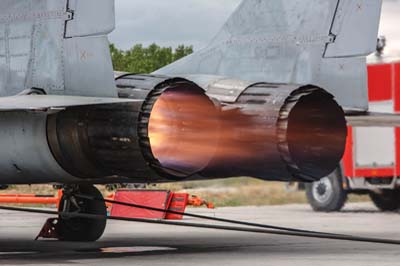 |
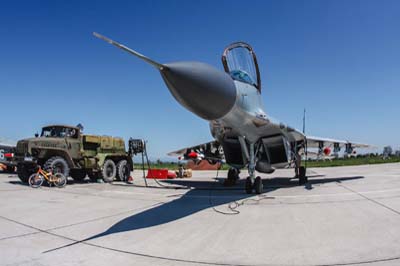 |
| Left to right: The MiG-21 being refuelled after its flight test. MiG-21's and MiG-29's on the main operational ramp at Graf Ignatievo. The MiG-29 engine vibration test. Air to air missile equipped MiG-29 on QRA duty. |
Krumovo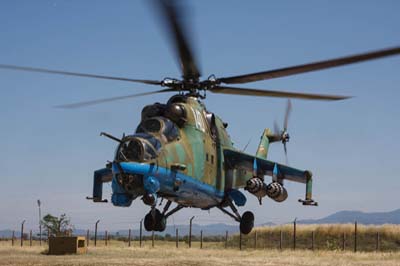 When I arrived at Krumovo air base we discussed what I wanted by Base Commander Gen Stefan Petrov. He asked if I would like to photograph one of his Mil Mi-24 Hind’s with its engines running. I queried the fuel shortage, but was assured that it could be done. Later in the day at the appointed time, I was driven out to the waiting attack helicopter, which was now being fuelled up for its run. I got all the static shots I wanted and was invited to sit in each cockpit. What caught my eye however was not this particular helicopter, but two lines of 20 or more Mil-24’s and Mi-17 Hip’s, one of which looked very interesting. It was a Mil-17PP (432) complete with an array of electronic eaves-dropping sensors mounted on each side of the fuselage. Having got this far I expected to photograph this later. This relic dates back to ‘Cold War’ times and last flew more than ten years ago.
When I arrived at Krumovo air base we discussed what I wanted by Base Commander Gen Stefan Petrov. He asked if I would like to photograph one of his Mil Mi-24 Hind’s with its engines running. I queried the fuel shortage, but was assured that it could be done. Later in the day at the appointed time, I was driven out to the waiting attack helicopter, which was now being fuelled up for its run. I got all the static shots I wanted and was invited to sit in each cockpit. What caught my eye however was not this particular helicopter, but two lines of 20 or more Mil-24’s and Mi-17 Hip’s, one of which looked very interesting. It was a Mil-17PP (432) complete with an array of electronic eaves-dropping sensors mounted on each side of the fuselage. Having got this far I expected to photograph this later. This relic dates back to ‘Cold War’ times and last flew more than ten years ago.Next to the Mi-24 being readied for me, was another Mi-24V (146) parked next to a rustic shed and an old blue lorry. As I lined up to make my shot of this interesting composition, there was a cry of "no, no"! A little startled, it was explained to me that I only had permission from the General to photograph the Mi-24V (140) which would be starting up soon. I queried the Captain’s explanation but he would not relent. I was later to determine that as the forbidden Mi-24 had a missing its main rotor blades, it fell in the category of being unserviceable and was consequently not to be photographed. I reasoned that those in charge did not want me to photograph anything that could be used to put the (BuAF) in a bad light. |
 |
 |
| Left to right:
Mi-17PP (431). Mi-24V (146) rotorless and it was suggested that it should not be photographed. Below: The aircrew which made perhaps the final flight in Mi-24V (140). |